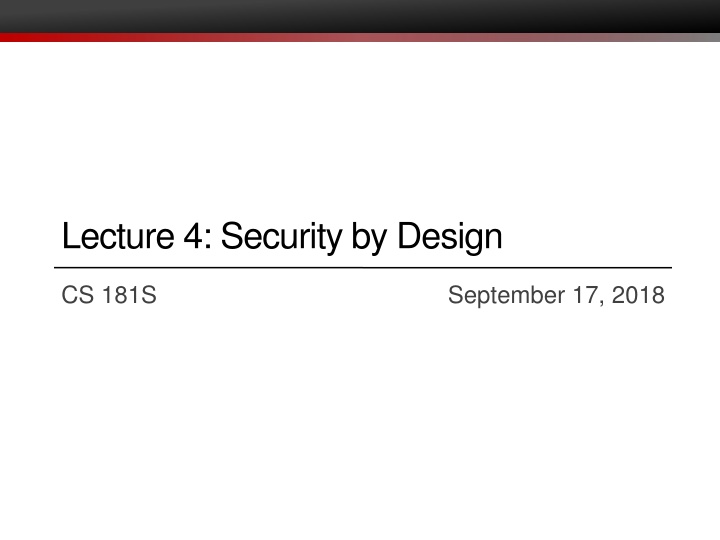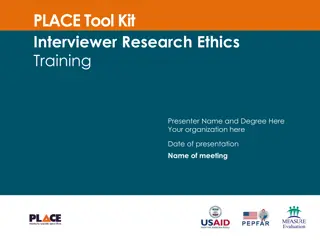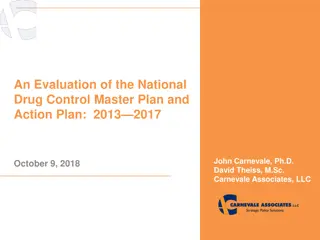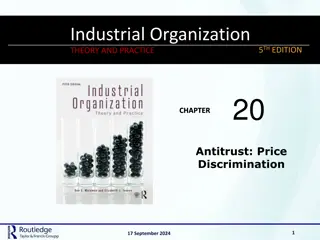
Security by Design: Functional Requirements, Assets, Stakeholders, and Threat Analysis
Learn about the importance of security by design in computer systems through understanding functional requirements, types of assets, stakeholders, and threat analysis. Explore examples and concepts to enhance system security.
Download Presentation

Please find below an Image/Link to download the presentation.
The content on the website is provided AS IS for your information and personal use only. It may not be sold, licensed, or shared on other websites without obtaining consent from the author. If you encounter any issues during the download, it is possible that the publisher has removed the file from their server.
You are allowed to download the files provided on this website for personal or commercial use, subject to the condition that they are used lawfully. All files are the property of their respective owners.
The content on the website is provided AS IS for your information and personal use only. It may not be sold, licensed, or shared on other websites without obtaining consent from the author.
E N D
Presentation Transcript
Lecture 4: Security by Design CS 181S September 17, 2018
1. Functional requirements Security = does what it should + nothing more Should be testable: a 3rd party could determine whether requirement is met User stories: brief description of single kind of interaction user can have with system "As a user I can action so that purpose" Examples from Sakai: As a professor, I can create a new assignment by specifying its name, number of possible points, and due date. As a student, I can upload a file as a solution to an assignment. These stories reveal system assets
Assets Types of Assets: physical objects (e.g., money) intangible objects (e.g., bank account balance) In computer systems: information is typically the main asset hardware and software could be assets people are not typically considered to be assets
Stakeholders Anything of value to a stakeholder in system could be an asset direct value: damage affects asset itself indirect value: damage affects something else, e.g. reputation An object is not an asset if it doesn't have value to some stakeholder A principal isn't a stakeholder if it doesn't value some system object We won't consider a generic "attacker" to be a stakeholder
Example: GMS Grade Management System: manages just the final grade for a single course Functional requirements: As a student, I can view my final grade. As a professor, I can view and change final grades for all students. As an administrator, I can add/remove students and professors to/from the course
2. Threat analysis Identify threats of concern to system Especially malicious, human threats What kinds of attackers will system resist? What are their motivations, resources, and capabilities? Best if analysis is specific to system and its functionality Non threats? Trusted hardware Trusted environment e.g., physically secured machine room reachable only by trustworthy system operators
Example: GMS Threat analysis: Students: Motivations: increase their own grade, lower others' grades, learn others' grades Capabilities: network access to servers, some physical access to others' computers, social engineering; probably not extensive computational or financial resources Out of scope: assume that threats cannot physically access any servers, profs are trusted, system admins
3. Harm analysis Harm: a negative consequence to a system asset Harm to... confidentiality: disclosure, interception integrity: modification, fabrication availability: deprivation, interruption "Performing action on/to/with asset could cause harm" e.g., "stealing money could cause loss of revenue" e.g., "erasing account balances could cause loss of customers"
Harm triples <action, asset, harm> e.g., <theft, money, loss of revenue> e.g., <erasure, account balance, loss of customer> Useful methodology: start with asset brainstorm actions that could harm asset let brainstorming be guided by CIA triad
Ex: GMS Asset: a numeric score for each student Functional requirements: students view grades, profs view and change grades, admins manage enrollment Threat analysis: students might be malicious or curious; profs are trusted; threats can't access servers physically Harm analysis: performing action on/to/with asset could cause harm Exercise: invent some harm triples <action, asset, harm>
4. Security goals "The system shall prevent/detect action on/to/with asset." e.g., "The system shall prevent theft of money" e.g., "The system shall prevent erasure of account balances" Specify what not how Poor goals: "the system shall use encryption to prevent reading of messages" "the system shall use authentication to verify user identities" "the system shall resist attacks"
Ex: GMS Exercise: transform harm triples <action, asset, harm> into security goals the system shall prevent/detect action on/to/with asset
5. Feasibility analysis Not all goals are feasible to achieve Relax goals: "prevent theft of items from a vault" to "resist penetration for 30 minutes" or to "detect theft of items from a vault"
From goals to requirements Goals: what should never happen in any situation not testable Requirements: what should happen in specific situations testable
6. Security requirements Constraints on functional requirements, in service of security goals Example: Functional requirement: allow people to cash checks Security goal: prevent loss of revenue through bad checks Security requirement: check must be drawn on bank where it's being cashed (so funds can be verified), or customer must be account holder at bank and depositing funds in account (so funds could be reversed)
Security requirements Constraints on functional requirements, in service of security goals Another example: Functional requirement: allow two users to chat using IM Security goal: prevent disclosure of message contents to other users (Poor) security requirement: contents of message cannot be read by anyone other than the two users (Improved) security requirement: message is encrypted by key shared with the two users doesn't over-commit to encryption algorithm, key size, etc.
Goals vs. requirements Goals Broad scope Apply to system Requirements Narrow scope Apply to individual functional requirements State constraints Testable Provide some details State desires Not testable Not about design/implementation details
Example: GMS Functional requirements: students view grades, profs view and change grades, admins manage enrollment Security goals: ... Security requirements: combine functional requirements with goals to invent constraints on system
Iteration Inventing new functional requirements Inventing new security requirements Introducing new assets Inventing new security goals
Example: Eleanor's Place New restaurant in Claremont You are contracted to build a system for online reservations What are the functionality requirements for this reservation system? What is the threat model? What confidentiality, integrity, and availability harms does Eleanor's Place face? What security goals should it have? Are they feasible? How could these be refined to security requirements?






















